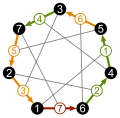Category:Related sets of 3-bit Walsh permutations; heptagon
The cycle on the left is the same as in the Heawood graph shown below.

The heptagon cycle in these images is always shown with counter-clockwise arrows (like in the permutation matrix).
The base edge is always the red one, changing all three bits. The yellow arrows change two bits. The green arrows change one.
Heptagon edges are marked with the bitwise XOR of the vertex numbers.
Each edge number is connected to the vertex with the same number.
(When the halves of each arrow are interpreted as edges, this is the Heawood graph.)
There are two chiral variants of the resulting heptagram pattern. It is the same for permutations in the same conjugacy class.
This leads to the following definition of these two conjugacy classes:
Let be the cycle of permutation , and let be any integer.
Then
is in conjugacy class
.
a and b in the following Python code are the cycles of the example permutations.
a = [1, 2, 4, 5, 7, 3, 6]
b = [1, 6, 3, 7, 5, 4, 2]
for n in range(7):
assert a[n % 7] == a[(n + 2) % 7] ^ a[(n + 3) % 7]
assert b[n % 7] == b[(n - 2) % 7] ^ b[(n - 3) % 7]
Subcategories
This category has the following 2 subcategories, out of 2 total.
Media in category "Related sets of 3-bit Walsh permutations; heptagon"
The following 4 files are in this category, out of 4 total.
-
Walsh permutation 245 heptagon.svg 287 × 281; 26 KB
-
Walsh permutation 276 heptagon.svg 287 × 281; 26 KB
-
Walsh permutation 612 heptagon.svg 287 × 281; 26 KB
-
Walsh permutation 615 heptagon.svg 287 × 281; 26 KB
















